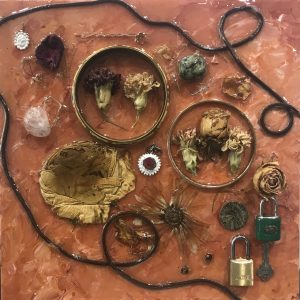
Madre de Flores by: Andriaanna Espinosa, Arcylic & Mixed Media, 2018
Beep! Beep! Beep! Ugh it’s 8 a.m.. That sound is terrible. I throw a pill bottle at my alarm clock and check my pulse. I’m still alive. That light is blinding. Who opened my curtains? I unplug my phone from the charger and see the weather forecast on my home screen. It’s 74 degrees, mostly sunny, with some mild wind. I hear that’s nice. It’s just another empty and bleak day to me, much like my existence. I’m dying, you see. I have been for years. I’m 40. No kids, no husband. I dated a guy once, 21 years ago. He was okay. He left after 277 days because “I was exhausting.” He was right, I am exhausted. I only wish we could have kissed. It would be my first and probably my last but that would have been irresponsible. I can’t risk infecting someone else.
I moved in with my mom around that time. Living on my own wasn’t plausible anymore. It took a couple years for us to adjust to that arrangement, mainly because I’m sick. She was in denial and couldn’t come to terms with my illness. She used to tell me I needed psychiatric medications and therapy. The thought of dying isn’t pleasant, and she was just looking out for my emotional wellbeing through that process. She’s a mom; no mom wants her child to be in pain, emotionally or physically.
I have over 15 of the rare conditions in my diagnostic manual. I bought it after my first serious illness when I was 11. I had anti-NMDA receptor encephalitis. It’s a rare form that affects your brain and makes you crazy. Pandas get it too. I don’t remember much, which I was told is normal. Since then, my body has been under attack. This manual is my shield. I must always be on alert.
“Samantha honey, you’re not a doctor” my mom always says after I find a new illness. Bless her heart. It’s not her fault, she just doesn’t understand.
Now Dr. Tanner understands. I saw 42 doctors; 29 in Oklahoma and 13 in Arkansas who weren’t competent enough to confirm my diagnoses. I have another appointment with Dr. Tanner today to “discuss my condition.” Conditions, plural, sounds more accurate.
“Are you sure you can’t eat anything sweetheart?” my mom asks while drinking her third cup of green tea. “I’m sure it won’t upset your stomach.”
Of course it will! Everything does. “No mom, I’m fine.”
After her fifth cup of green tea, we finally get in the car and head to Dr. Tanner’s.
There’s very little parking in the hospital garage as usual. We park on level D and start walking to the elevator. Dr. Tanner’s office is suite 200, a 6 minute walk.
“I hope we won’t be late” my mom said when we got out of the elevator. That’s just what I need, a late fee. Medical bills are expensive, but what else can you do when you have 15 rare conditions? It’s the price to pay to stay alive.
Patricia, the office receptionist, greeted me with her usual “Good morning Samantha, you’re looking well” when we arrived. Of course I don’t look well, but she says that to make me feel better. I fill out the same old sign-in slip with the same old answers: no I don’t have insurance, no I’m certainly not a new patient. I hand it to Patricia with my credit card. “You’re all set, Dr. Tanner will be with you shortly.”
I always sit on the first chair to the left of the door. Today it’s occupied by a snotty little boy. I hope he doesn’t leave his germs behind. I take a seat by the coffee table and my mom follows. Now we wait. I can feel everyone staring at me, because of my sickly appearance I’m sure. This is a doctor’s office, people. I’d be more inclined to stare at someone who doesn’t look ill.
I wonder what Dr. Tanner and I will talk about today. I reach into my messenger bags and take out my grey notebook. This is where I track my symptoms, diagnoses, the treatments I want, the treatments Dr. Tanner wants, and all important reactions. The most recent medication he prescribed had no effect. He said it was pricey so he gave me samples instead of a slip. He’s kind like that. If only it worked. If only anything worked.
I check my watch and see that he’s 10 minutes late. That’s rather unlike him. Dr. Tanner enjoys our visits. It’s like a game, a challenge. “Samantha?” someone calls. I look up and see a very not Dr. Tanner man. Dr. Tanner is 5’5” with a dark rusty beard, and he always smells like maple syrup and rain. This man is well over 6’ and is wearing a suit jacket over a plain grey T-shirt. That’s not proper doctor attire if you ask me. I doubt he smells like maple syrup and rain. Probably more like an onion bagel and leather. Maybe there’s another Samantha waiting. I look around and no one seems to be responding. Then I see it. He’s holding my 3-inch wide file. “Hi Samantha, I’m Dr. Peterson and I’ll be talking with you today.”
“Where is Dr. Tanner?” I ask as politely as I can. I can’t make a scene. I can feel everyone staring. Some redheaded woman loudly bickered with Patricia last week. Insurance something or other. It’s rather inconsiderate to publicly argue. I stuff my grey notebook into my bag, drape it over my shoulder, and follow this doctor to room 6. I’m always in room 11. It doesn’t have a window and the air is cleaner. There is one long, horizontal window above a leather couch. Why is there a couch? That’s not very exam-roomy if you ask me.
He gestures to the couch and I take a seat. He sits on the rather large leather chair. As he crosses his legs I can see he’s wearing plaid yellow socks, something an elementary school teacher would wear I’d imagine. Dr. Peterson begins asking questions. “Can you tell me about your illness when you were 11?” I proceed to recount the events I remember and the details my mom has given. Then he asks how long I’ve been feeling lethargic, achy, swollen, how long I’ve had headaches, nausea, and dizziness. It’s typical procedure to question a new patient’s medical history. The previous doctor may have left out information in their notes.
“Where is Dr. Tanner? I don’t understand why I’m meeting with you or why Dr. Tanner didn’t mention this appointment change.”
“I’m a psychiatrist, Samantha. I work alongside Dr. Tanner and some of the other physicians on an as needed basis. I’ve spoken with your mom and Dr. Tanner, and they’re both concerned about you. I’d like to help.”
“That’s very kind of you. I’m not sure what you mean by help, though. You said you’re a psychiatrist? I don’t want to be rude but my issues are in my body, not my brain.”
“Samantha, have you heard of hypochondria?”
Is this guy serious? “Yeah. It’s when someone thinks they have all these medical issues but they don’t, right? What does that have to do with me?”
“I’ve gone through your bloodwork and tests. All of your results have come back negative, Samantha. Physically, there’s nothing wrong with you. I believe you’re a hypochondriac. Now, I’ve scheduled a psychiatric evaluation for you, and I have some literature I want you to read.”
I can’t believe this guy! He’s acting like my mom used to. Like my mom, I can tell that his motives are pure. I guess it’s hard for anyone to accept so many diseases, even a doctor. I’m not going to argue with humanity. He just cares. I don’t want to shatter his hope, so I just smile and nod. He should feel good about our visit at least. It’s not his fault. 15 rare conditions is a big pill to swallow for any doctor. The compassionate thing to do is let him live comfortably in denial while I suffer with the truth.
After a few more minutes of explanations and concern, he stands up and hands me two books that I’ll never read. Maybe I’ll donate them to the hospital library. That would be nice. I shake his hand and walk towards Patricia’s desk to schedule my next appointment.
“When would you like to come back, Samantha?”
He went through the trouble of letting Dr. Peterson talk to me. He didn’t have to do that. He could have been honest with him about how sick I really am, but I’m sure he didn’t want to upset a colleague. He’s kind like that.
“I’ll call and schedule it later.”
